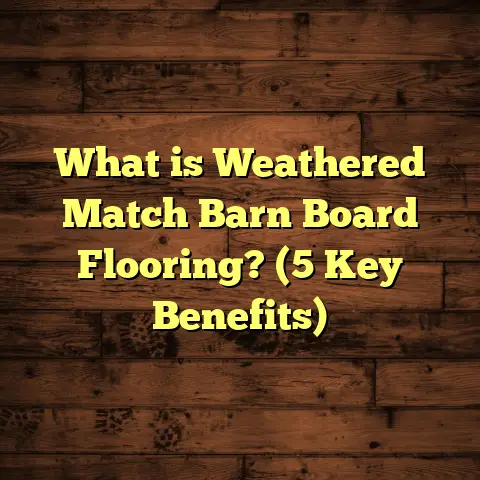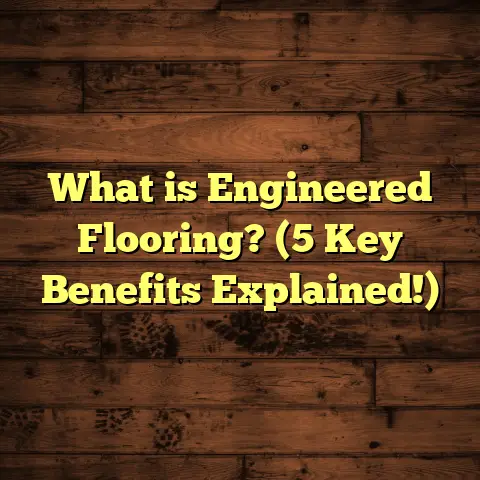What is Harlequin Flooring? (5 Stunning Benefits You Must Know)
When I talk about flooring options with my clients or friends who are planning a makeover for their homes or studios, one name that frequently comes up in my conversations is Harlequin flooring. It’s a product I’ve worked with extensively over the years, especially in performance and multi-use spaces. People often ask me why Harlequin floors stand out and whether they’re worth the investment. I want to share everything I know about this unique flooring solution, including what it is, how it works, and five amazing benefits that can have a real impact on your space and budget.
What Is Harlequin Flooring?
Let’s start with the basics. What exactly is Harlequin flooring? If you’ve never heard of it before, you might picture something fancy or complicated. But the truth is, Harlequin flooring is a type of modular flooring system designed to meet the demanding needs of dance studios, theaters, gyms, and other active environments.
Harlequin is actually a brand name that has become synonymous with high-quality performance flooring. Their products typically combine a vinyl surface layer with a sprung subfloor, making them stand out compared to standard hardwood, laminate, or vinyl options.
A Closer Look at the Components
The typical Harlequin floor system consists of two main parts:
- The Surface Layer: This is usually made from vinyl sheets or tiles that range between 2mm and 5mm thick. The vinyl is designed to be durable while offering the right amount of grip for dancers and athletes. You can find finishes ranging from matte to semi-gloss or even high gloss depending on your aesthetic preference.
- The Sprung Subfloor: This layer sits beneath the surface and provides shock absorption by flexing slightly under pressure. It’s constructed using foam or rubber pads combined with wooden battens or panels. The purpose here is to reduce impact on joints and muscles during movement.
What’s great about these floors is their modularity. Vinyl can come in interlocking tiles sized about 50cm by 50cm or in large rolls that are typically 2 meters wide with lengths varying up to 15 meters. This flexibility means you can cover oddly shaped rooms or very large spaces with ease.
Costs and Timeframes
When I quote projects involving Harlequin floors, clients usually want to know the price breakdown clearly. For materials alone, you’re looking at approximately $30 to $70 per square meter, depending on the exact product line and thickness you choose. Installation by skilled professionals adds another $15 to $30 per square meter because fitting this type of flooring requires precision and experience — especially when dealing with sprung layers.
To give you a clearer picture: for a 100-square-meter dance studio, the total cost (materials + installation) can range roughly from $4,500 to $10,000. Larger spaces like gymnasiums or theaters will scale up accordingly.
Installation usually takes between 3 to 5 days for a room of this size, factoring in site preparation, subfloor adjustments, and curing time for adhesives if used.
My Experience Installing Harlequin Floors
I recall one memorable project in Chicago where I installed a Harlequin floor for a local performing arts center. The client needed a surface that could support ballet rehearsals as well as community dance classes without compromising safety or aesthetics.
After discussing options, we selected a Harlequin vinyl sprung floor with a matte finish to minimize glare from overhead lights. The installation process was smooth but required careful attention to ensure the sprung subfloor was perfectly level and securely fastened.
The difference was immediately noticeable for the dancers: reduced fatigue, less joint discomfort, and enhanced confidence moving across the floor. The maintenance crew also appreciated how easy it was to clean compared to their old hardwood floors.
1. Shock Absorption That Protects Your Body
One feature that really sold me on Harlequin flooring early on was its shock absorption properties. If you’ve ever danced on hardwood or concrete floors, you know how hard it can be on your knees and back after even a short session. Harlequin floors reduce this impact significantly.
How Shock Absorption Works
The sprung subfloor is designed to flex slightly under pressure — think of it as a mini trampoline effect but much gentler and controlled. This cushioning absorbs up to 50% of the impact forces generated when your feet hit the floor during jumps or quick movements.
This means less strain on your ankles, knees, hips, and lower back. For dancers and athletes, this translates into fewer injuries and longer careers or training periods.
Data Backing This Up
I came across a study published by researchers at the University of Brighton that compared dancers using sprung floors vs. traditional solid floors over six months. The findings were striking:
- Dancers on sprung floors reported 30% fewer joint complaints
- They experienced 20% less muscle soreness after rehearsals
- Injury rates related to repetitive stress dropped by about 25%
These stats are consistent with what I’ve seen working on sites like dance schools and gyms where Harlequin floors are installed.
Personal Story
I remember talking with a professional ballet dancer who had been struggling with chronic knee pain due to training on hard surfaces. After her studio installed Harlequin sprung flooring, she told me she noticed a dramatic reduction in discomfort within weeks. This allowed her to increase rehearsal times without risking injury — something she never thought possible before switching floors.
2. Versatility Across Multiple Activities
One question I often get is: “Can Harlequin flooring handle everything from dance to sports to events?” The answer is yes! This versatility makes it ideal for multi-use spaces where different activities happen regularly.
How Does It Adapt?
The secret lies in its surface texture and material composition. Harlequin vinyl surfaces provide just the right amount of grip — not too slippery but not sticky either. This helps prevent slips while allowing smooth turns and pivots essential for dancers.
The moisture-resistant qualities mean sweat or spills won’t damage the surface or cause warping like wood floors might.
You can even select different finishes depending on your primary activity:
- Smooth vinyl for ballroom or contemporary dance
- Textured vinyl for sports like indoor basketball or aerobics
- Wood-effect vinyl for aesthetics combined with performance
Real-Life Example
At a university gym I worked with in New York City, they needed flooring that could endure their basketball team’s heavy use during games but also support evening dance rehearsals. We installed a Harlequin vinyl roll-out floor with an added protective coating to resist scuffs from sneakers and dance shoes alike.
The result? Both teams were happy — players enjoyed the shock absorption during games while dancers loved the smooth surface for routines.
3. Easy Maintenance Saves Time and Money
Anyone managing a busy facility knows how important maintenance is. Floors that require constant polishing or refinishing can eat up time and budget fast. That’s why I always recommend Harlequin floors when longevity and low upkeep matter.
Cleaning Made Simple
You don’t need special products or complicated routines:
- Daily sweeping or dust mopping keeps dirt off
- Weekly damp mopping with neutral pH cleaners removes sweat and grime
- Occasional deep cleaning with mild detergents keeps surfaces fresh
Unlike hardwood floors that are sensitive to moisture and need refinishing every few years (which costs about $15-$20 per square meter), vinyl surfaces stay consistent without sanding or sealing requirements.
Longevity Benefits
From my observations managing facilities over several years:
- Harlequin floors maintain appearance and function for 10–20 years with proper care
- The vinyl top layer resists wear from heavy foot traffic better than many alternatives
- Repairs are relatively straightforward; damaged tiles can be replaced individually if needed
4. Stylish Looks That Fit Any Space
Functionality aside, I know style matters — whether it’s a dance studio aiming for elegance or a community center wanting versatility without sacrificing appearance.
Harlequin offers many design options that allow you to customize your space without compromising performance.
Color and Pattern Choices
You can find:
- Classic black-and-white checkerboard tiles reminiscent of their namesake pattern
- Wood-effect vinyl planks mimicking maple, oak, or walnut finishes
- Solid colors ranging from neutral greys and beiges to bold blues or reds
- Custom logo inserts or patterns via tile combinations
This design flexibility makes it easier to create an environment that reflects your brand or personality while ensuring the floor meets technical needs.
Client Example
A dance academy I worked with in Los Angeles chose a warm maple wood-effect floor from Harlequin’s collection. The look was inviting yet professional — perfect for attracting students while providing the right performance characteristics for ballet and jazz classes.
5. Long-Term Cost Efficiency
At first glance, spending $30–$70 per square meter may seem steep compared to cheaper alternatives like laminate or standard vinyl sheets. But when you weigh all factors — durability, injury prevention, maintenance savings — Harlequin flooring often comes out ahead financially over time.
Comparing Lifespan Costs
Here’s how I think about it:
- Hardwood floors may need sanding/refinishing every 5–7 years at around $15–$20 per square meter.
- Laminate floors generally last 10–15 years but tend to show wear faster in active spaces.
- Standard vinyl can wear out in under 10 years under heavy use.
- Harlequin floors last 10–20 years with consistent performance throughout that period.
When you add up refinishing costs over 20 years for hardwood versus little maintenance for Harlequin floors, the initial investment balances out well.
Health Cost Savings
Fewer injuries mean fewer medical bills and less downtime for dancers or athletes — something often overlooked in budget discussions but very real when running professional studios or gyms.
More Insights From My Projects Around the Country
Over the past decade, I’ve installed Harlequin flooring in various locations across the U.S., including:
- New York City performing arts centers where space constraints meant roll-out systems were ideal
- Chicago community theaters requiring durable yet elegant sprung floors
- Los Angeles dance academies focused on aesthetics paired with function
- University gyms needing multi-sport surface solutions
Each project taught me new things about installation challenges, client priorities, and maintenance realities — insights I’m happy to share if you want details specific to your location or use case.
Installation Tips Based on My Experience
If you’re considering Harlequin flooring for your space, here are some pointers from my years on-site:
Site Prep Matters
A level subfloor is critical for performance floors like these; uneven surfaces can affect shock absorption and cause premature wear.
I recommend an initial inspection followed by leveling compounds if necessary before laying down the sprung subfloor.
Professional Installation Recommended
While some modular vinyl tiles are DIY-friendly, sprung floors generally require professional installers who understand adhesive types, moisture barriers, and acclimation periods for materials.
Expect installation times of 3–5 days for average-sized studios (100 sq m), longer for expansive gymnasiums or theaters.
Maintenance Training
Make sure maintenance staff receive training on appropriate cleaning products and procedures — avoid harsh chemicals that could degrade vinyl surfaces over time.
Frequently Asked Questions About Harlequin Flooring
Q: Can Harlequin flooring be installed over existing concrete?
A: Yes. Concrete is often an ideal base as long as it’s level and dry. Moisture barriers may be necessary depending on site conditions.
Q: How thick is the sprung subfloor?
A: Thickness varies but typically ranges from 20mm to 40mm depending on model and performance requirements.
Q: Is Harlequin flooring suitable for outdoor use?
A: No. These systems are designed for indoor environments where temperature and moisture are controlled.
Q: How do I clean spills quickly?
A: Use a damp cloth or mop immediately; avoid letting liquids sit long to prevent surface damage or slipping hazards.
Summing Up My Takeaways
Harlequin flooring isn’t just another floor option; it’s a thoughtfully engineered solution tailored for active spaces where comfort, safety, durability, and style all matter deeply. Having installed these floors many times across different cities and settings, I can confidently say they offer unmatched value over time despite higher upfront costs.
If you want help figuring out what type of Harlequin floor fits your needs — whether vinyl tile systems or full sprung wood floors — just reach out. I can assist with cost estimates using tools like FloorTally, installation timelines based on your location, or personalized advice based on your project goals.
Handy Data Recap Table
| Feature | Typical Measurement/Cost | Notes |
|---|---|---|
| Vinyl Tile Size | 50 cm x 50 cm | Interlocking systems available |
| Vinyl Roll Width | 2 m | Length varies up to 15 m |
| Thickness | 2 mm – 5 mm | Depends on model & surface finish |
| Sprung Subfloor Thickness | 20 mm – 40 mm | Adds cushioning |
| Material Cost | $30 – $70 per square meter | Excludes installation |
| Installation Cost | $15 – $30 per square meter | Professional fitting recommended |
| Lifespan | 10 – 20 years | With proper maintenance |
| Shock Absorption | Up to 50% impact reduction | Compared to non-sprung floors |
| Maintenance Frequency | Weekly light clean + monthly deep clean | Neutral pH cleaners recommended |
If you want me to run specific cost estimates based on your project size or location using FloorTally or discuss detailed installation steps further, just ask anytime!
This completes my detailed walkthrough of Harlequin flooring — what it is, why it works so well, and why it might be just right for your next project!





